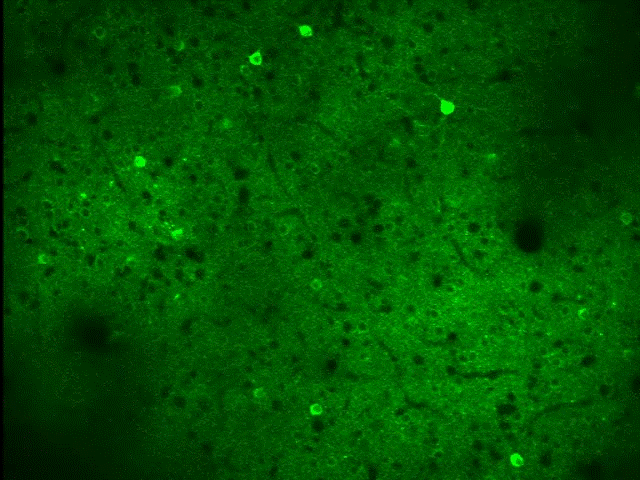Poking electrodes into tissue is direct but it’s invasive and doesn’t reveal which cell has been sensed. Engineering neurons to flash with light when calcium levels peak is less invasive and shows the exact cell that’s spiking, but it’s an indirect indicator of electrical activity and quickly becomes muddled when flashes overlap. To improve how well the timing of spikes can be estimated from flashes, researchers at IIT Madras and MIT have developed a powerful algorithm with inspiration from the analysis of speech and music.
As reported recently in a paper in IEEE Transactions on Signal Processing, the team shows that the algorithm, called GDspike, often performs better than some other popular methods. Its greatest power, however, appears to be that when used in combination with a particularly successful model-based method called MLspike, it can improve analysis even more.
“GDspike performs reasonably well,” said co-senior author Mriganka Sur, Newton Professor of Neuroscience in MIT’s Picower Institute for Learning and Memory. “But in particular when you use modeling and then apply this on top of it, it performs really well. That is one of best ways to deconvolve signals to date.”
Sur ‘s neuroscience lab constantly uses calcium fluorescence to track neural activity, for instance to study how neurons in different brain regions communicate to guide behavior. That’s put him on the front lines of the problem of estimating spike patterns. Since working with the team of co-senior author Hema Murthy, Professor of Computer Science at IIT Madras, to develop GDspike, he said, he has begun combining it with MLspike to improve his lab’s analysis of experimental data.
Though more work should be done to further validate GDspike’s value, Sur said, he believes other neuroscientists will consider using it, too.
“We hope that, over time, this will be accepted by the field,” he said. “Neurophysiologists are very opportunistic. If something works very well they will use it, so the onus is on us.”
Murthy added that the algorithm may also prove useful in guiding machine learning approaches to spike estimation and similar problems by aiding in the detection of spike events. That, in turn, could make machine learning much more efficient.
“Signal processing can direct machine learning,” she said. “The experiments with the Sur Lab convince us that appropriate signal processing can be used in tandem with machine learning algorithms thus leading to significant savings in power.”
Computation and comparison
The metaphor that neurons speak in patterns of spikes and intervening calmness provides a fitting context for the development of GDspike because its computational inspiration arose from signal processing methods developed by Murthy for tasks such as distinguishing sources of sound in music or recognizing individual speakers. The waveform of a flash of calcium fluorescence – the particular way the amplitude rises quickly but decays slowly – shares crucial characteristics with spoken syllables or beats of percussion, the authors noted. These and other observations of the nature of calcium fluorescence signals allowed the team to base their approach on “group delay” functions of signal processing.
The paper, with former IIT Madras graduate student Jilt Sebastian as lead author, lays out a mathematical proof of GDspike’s ability to isolate spikes from within those waveforms. Given the practical realities of its intended application, the authors also put it to the test on actual neural data, comparing its accuracy and speed with three other methods used for spike estimation. MLspike models neuronal spikes. Another method called STM relies on machine learning models. The Vogelstein algorithm, meanwhile, is based on a different signal processing approach.
The team ran each of the four methods on nine datasets for which both calcium fluorescence and “ground truth” electrical spike measurements were known. They compared metrics of how similar the estimated spikes were to the real ones, whether there were false positives or negatives and how long each analysis took on the same computer.
In all, GDspike performed well, frequently beating Vogelstein, though running about a minute slower. STM typically performed better, but GDspike had an advantage or parity in some cases. GDspike was also sometimes better than MLspike, but ran much faster. When the team combined GDspike with MLspike, they often achieved significantly better results than either method delivered alone.
“The combined approach makes use of the ability of MLspike to detect the precise [spike] locations and the ability of group delay to convert it to a more resolved shape,” the authors wrote.
A product of partnership
The collaboration between Sur’s lab and the IIT Madras team that forged GDspike has grown steadily.
Sur helped spark the GDspike project when he spoke to the IIT Madras team about the challenge of decoding calcium fluorescence signals and the importance of accurately estimating spike times. Members of Murthy’s lab, rich in the needed signal processing expertise, visited Sur’s lab to learn the neuroscience needed and its applications.
The collaboration is part of IIT Madras’s effort to build a program investigating the intersections of neuroscience and engineering. In 2015, the institute launched the Center for Computational Brain Research. Sur and two other U.S.-based Indian academics were named “Chair-Professors” of the center.
Sur now has several studies underway with collaborators from IIT Madras. In one project with Murthy’s group, for instance, they are analyzing how different areas of the cortex work together to process information, a longstanding interest of Sur’s that poses interesting computational questions. In another, they are examining the human electroencephalogram (EEG) and using advanced machine learning techniques to extract high-level information present in these easily recorded signals.
“I have learned a lot from them, and I hope we have shaped their work a little”, Sur said. “It’s a richly rewarding collaboration.”
Murthy agreed, “Our team has also tremendously benefited from this collaboration.”
In addition to Sebastian, Murthy and Sur, the paper’s other authors are Mari Ganesh Kumar and Venkata Subramanian Viraraghavan.
The Center for Computational Brain Research at IIT Madras funded the research.






